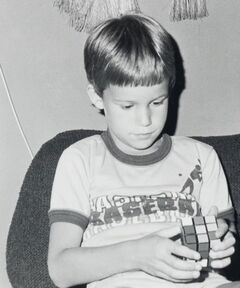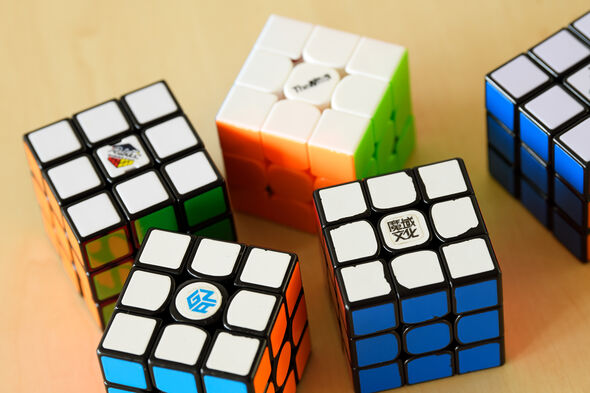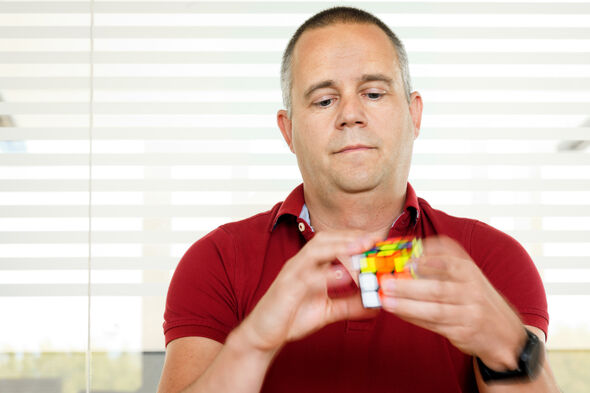
Fascinated by the Rubik's Cube
The Rubik’s Cube celebrated its 44th anniversary this year. What once started as a method to give students better spatial insight, grew into a worldwide puzzle-solving craze. Nowadays the cubes are available in all shapes and sizes and players compete for the fastest solving time in the so-called speedcubing contests. But who would have thought that speedcubing also has a calming effect? Professor Kees Storm explains why speedcubing is the ideal form of mindfulness for him.

The world record is currently at 4.22 seconds. Kees' own record is 18.71 seconds. To beat the world record holder is certainly not his goal. Solving the cube (quickly) just gives him a good feeling. "Ever since I was a child I have been fascinated by the Rubik's Cube, which was just introduced on the market at that time. I wasn’t able to solve it then and there were no useful tutorials on YouTube. I left the cube for what it was. Until a few years ago, when my children brought up the subject. Then it started to itch again: as a beta and as a father I have to be able to solve this, right?"
By doing it a lot and learning the necessary algorithms by heart, it becomes an automatic: both mentally and physically
A computational mindset
"In my research group Theory of Polymers and Soft Matter we make computer models of materials and I am busy with complex matter every day. We study the materials that you and I are made of: tissue, cells, skin, et cetera. Important materials with fantastic properties: accommodating, self-healing, recyclable. We want to take them as an example in making other synthetic materials. Learning from nature and looking at its best tricks. Much of my work is computational: writing algorithms. This algorithmic way of working and thinking is exactly the approach that you have to use when solving the Rubik's Cube: breaking up the problem in subtasks. Step by step, without losing sight of the end goal."
Mindfulness
"I always have a few cubes in my office and use them as a mini-break between work. As a mental 'reset' and a form of mindfulness. That may sound like a paradox: the cube is obviously quite complicated. But by doing it a lot and learning the necessary algorithms by heart, it becomes an automatic: both mentally and physically. You rely on mind and muscle memory. The movements go smoothly and they come naturally. If you solve the cube in this way, you are really just doing that and your mind does not go anywhere else. I think speedcubing or Rubik's Cubing is a good hobby for scientists in general. Everyone can use a reset of the mind sometimes: lose yourself mindfully in a task. Just be busy with the cube in the here and now. And dividing large problems into sub-problems to get to a complicated insight, isn’t that the essence of science? Asking big questions and coming up with the answer by taking small, methodical steps."
Dividing large problems into sub-problems to get to a complicated insight, isn’t that the essence of science?
Everyone can learn how to do it
"I started on YouTube: it's incredible how many people put all kinds of good tutorials on there for free. After a few days I succeeded. First you have to get the basics, gain insight into your cube. Then the method of learning the method by heart and then do it often to get faster. Solving the puzzle still gives me a kick every time I do it."
The Rubik's Cube fascinates many people worldwide: it is difficult but it is possible. You cannot solve it by accident. You really need (spatial) insight and a strategy, but it is a misunderstanding that you also need a mathematical background to be able to solve the cube. Everyone can learn how to do it. That is why Storm has also published a beginner's method in which he explains six algorithms that are needed to solve the cube. "I like it when I can do something and convey that knowledge. If I didn’t, I would not work in the field of education. It is a big part of my work to teach people new things. And this specific topic gives me so much joy: I want others to experience that too."
Think like a computer
"To solve the Rubik's Cube you have to teach yourself to solve a problem like a computer would. You have to look very systematically at the configuration of the cube, and then work towards the solution in steps. The problem is too complex to oversee at once, but if you know all the steps and go through the right sequence, you will always manage."
"It already helps enormously to analyze the problem properly. Not everything moves on a cube: the six middle spaces are static. All you have to do is put the eight corner cubes (where three colors come together) and the twelve edge blocks (with two colors) in the right place. If you want to become fast, work from a fixed orientation and turn the entire cube as little as possible. You must always solve the blocks, one by one or a few at a time, in context and do not destroy what has already been solved. In the entire process it is important to always keep in mind what situation you are in, what your next step should be and then to find the right algorithm."
According to Storm becoming faster is a matter of repeating and learning more algorithms. His beginners model has six algorithms. To solve the cube in about twenty seconds, you need to know about eighty, but the real world masters in speedcubing know more than 250 algorithms.
Rotations
With the help of computers it has been proven that a maximum of twenty rotations are needed to solve the cube. Storm: "That is why it is remarkable that the very fast boys and girls in speedcubing typically make about fifty to sixty moves to come to the solution. They know so many algorithms and can execute them so quickly, that on balance, even though more twists are needed, the problem is solved faster. Besides the speedcubing, there are also competitions where it is the aim to solve the cube in as few spins as possible. That is extremely difficult. Something new that I would still like to learn in this area is to solve the cube blindly. That seems impossible to me now, but there are so many people who can do it, so I should be able to learn it as well."




Discussion